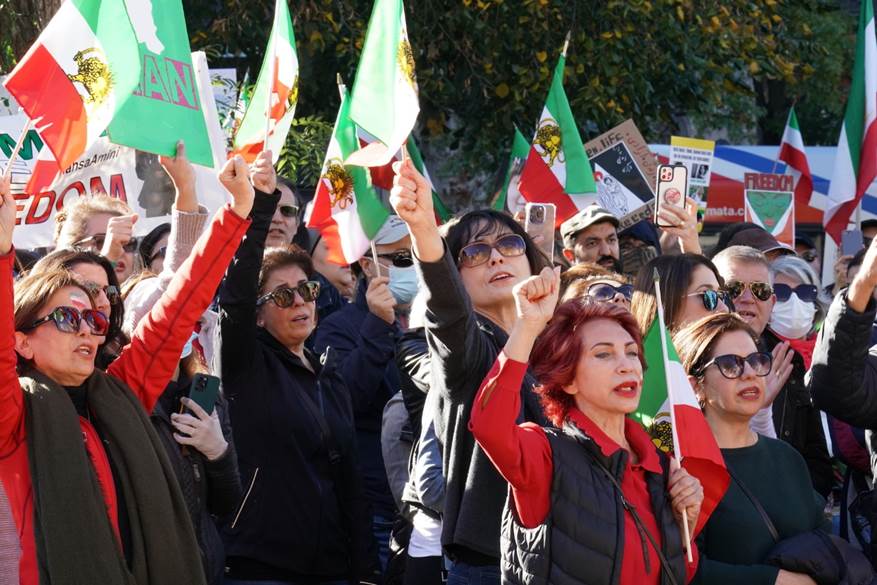
Iranian Americans Show Support for Protesters
By Phil Pasquini

Washington: On October 29 Islamic Revolutionary Guard Corps (IRGC) leader Hossein Salami warned demonstrators in the ongoing anti-hijab protests that today was “the last day for riots.” A none too veiled threat the government would no longer tolerate social unrest of any kind warning participants not to “take to the streets.”
On Saturday, Iranians in Washington continued their efforts in showing support and solidarity for the brave protesters in Iran and their ongoing efforts to overthrow the murderous government with a massive demonstration at Farragut Square.
It is estimated that thus far around 250 people have been killed in Iran during the almost seven weeks of protests following the death of 22-year-old Mahsa Amini, a Kurdish woman who died while in custody of the morality police last month. Her crime was not wearing her hijab properly while visiting Teheran. According to police she died as a result of a “heart attack.”
Several speakers at the rally sounded the alarm the regime is doomed in what was described as a revolution to end the reign of the clerics. One speaker noted the only thing the ruling body understands is to kill anyone who criticizes or opposes the regime and that no amount of intimidation by them will divert their will for change. Women, Life, Freedom is their call to arms in order to realize a free and democratic Iran.
Speaking at the Center for Strategic and International Studies (CSIS) earlier this month, Yeganeh Rezaian of the Committee to Protect Journalists (CPJ), an Iranian journalist, spoke from her personal experience on the current situation in Iran. Rezaian, along with her Iranian American husband Jason, a Washington Post journalist, were arrested in 2014, jailed and charged with spying for the US. While she was released, her husband was held in prison for 544 days including solitary confinement before his release in 2016.
When asked about the state of a revolution, she responded by saying, “I definitely see it as the beginning of a revolution. The reason for such a difference this time around and calling it a ‘revolution’ is that it includes a variety of communities – religious minorities, racial minorities, different socio-economic backgrounds - they all came together. Even fundamental religious Iranians who are called Basseris have joined this revolution. And the fact that this time around people are asking for fundamental change, not for small changes. People are not asking for reform within the system. People are asking for the change of the system. This time around the younger generation…are out in the streets sacrificing everything they have including their lives. I call it a women-led revolution because it started as a protest against 40 years of gender apartheid that this regime imposed on Iranian women and I really appreciate the support of Iranian men.”
On a more somber note, regarding the brutality and killings by the regime in an attempt to halt the ongoing and growing protests, many have called for a revolution, she stated, “I believe it will take a long time because this is a regime that does not shy away from killing people. I don’t think this regime goes anywhere until thousands of thousands of Iranians are killed.”
Regarding a revolution in Iran by any academic measure, Kirsten Fontenrose, a nonresident senior fellow with the Atlantic Council’s Scowcroft Middle East Security Initiative, opined that she does not see any signs that the movement so far is anywhere near meeting all the indicators of a revolution at hand.
“We’ve so many protests over the past 20 years in Iran that we kind of default to a position of it’s not really going to amount to anything; the regime will crush it. And while that may still be the case, speaking about it as a revolution changes the way the international community thinks about it. It suddenly looks like something we could back or something that might have a future. One thing I think we have to remember is that no one understands revolution in Iran as well as the current regime. When you use the phrase ‘revolution’ it no longer becomes we’re asking for change within the system, it becomes an existential threat and what we know about this regime is that their one motive is staying in power. There is not much else we can leverage with them. That existential threat then becomes a call to arms, so I think once you frame it as a resolution you wake up the international community, but you also wake up the regime in whole new ways and potentially could unleash things from them as well.”
While academic indicators for revolution may be an important factor for analysts and foreign policy framers, protesters for change have little concern as to definition and are hopeful their sacrifices will result in the removal of the regime.
By demonstrating both here and in Iran their ongoing actions are seen by many as fomenting a revolution from within, while they remain hopeful that by throwing a rock into the regime’s pond a small ripple will grow into a tsunami of change for a new democratic and free Iran.
Report and photos by Phil Pasquini
(Phil Pasquini is a freelance journalist and photographer. His reports and photographs appear in the Washington Report on Middle East Affairs and Nuze.ink. He is the author of Domes, Arches and Minarets: A History of Islamic-Inspired Buildings in America.)

